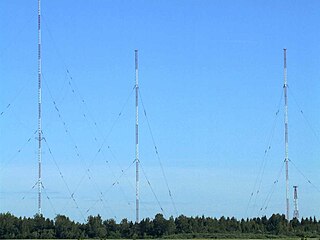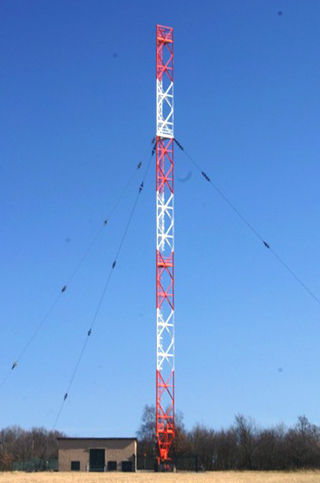
The Nordkirchen transmitter was a medium-wave broadcasting facility of Media Broadcast and former Deutsche Telekom near Nordkirchen in Northrhine-Westphalia, Germany. It was built in 1979 and 1980 after and finally de-funct in 2018.

The Nordkirchen transmitter was a medium-wave broadcasting facility of Media Broadcast and former Deutsche Telekom near Nordkirchen in Northrhine-Westphalia, Germany. It was built in 1979 and 1980 after and finally de-funct in 2018.
It transmitter had 100 kW power and uses a directional antenna on 549 kHz aimed at the Northeast, consisting of two ground-fed, guyed, lattice steel masts 136 metres apart. The power opposite the antenna's focal point was approximately one-third the total radiated power. This avoided conflicting with the nearby Wavre transmitter in Belgium, which works on the neighbouring 540 kHz frequency.
In 2004, a second medium-wave transmitter with a power of 5 kW for transmitting the privately owned radio programme Truckradio was installed at Nordkirchen transmitter, which uses the same antenna as the transmitter of Deutschlandfunk. [1]
First the 5 kW transmitter got de-funct and later the main transmitter. In 2018 the facility got rebuild.

Sender Zehlendorf or Zehlendorf (radio) transmission facility was a radio transmission facility which was in service since 1936, when a short wave transmitter was built on the occasion of the Berlin 1936 Summer Olympics in Zehlendorf as part of the establishment of permanent radio services. This Zehlendorf site, which until the end of World War II was referred to as the Rehmate Radio Transmission Centre, had 26 different antennas at the time.

The Roumoules transmitter is the main broadcasting facility for longwave and mediumwave broadcasting of Radio Monte Carlo near Roumoules, France and is owned by Monaco Media Diffusion. The 1000 and 2000kW transmitters installed are among the most powerful in the world and can be received well at nighttime throughout Europe.

The Mühlacker Broadcasting Transmission Facility is a radio transmission facility near Mühlacker, Germany, first put into service on November 21, 1930. It uses two guyed steel tube masts as aerials and one guyed steel framework mast, which are insulated against ground. It has two transmission aerials for shortwave and one free standing steel framework tower for directional radio services. The shortwave transmitter was shut off on October 19, 2004. The medium wave transmitter was switched off in January 2012.

The AM transmitter in Burg, near Magdeburg, Germany, is a huge facility for longwave and mediumwave broadcasting. Its most dominant constructions are a 324-metre guyed radio mast and two 210 metre guyed steel tube masts.

The Langenberg transmission tower is a broadcasting station for ananlog FM Radio and Digital-TV signals. It is located in Langenberg, Velbert, Germany and owned and operated by Westdeutscher Rundfunk, WDR.

Transmitter Berlin-Britz was a broadcasting facility for medium wave, shortwave and FM on the site of a former tree nursery in Berlin-Britz. It was established in 1946 and until 1993 it was the most important transmitter of RIAS. It was used by Deutschlandradio until 4 September 2013, and was finally demolished on 18 July 2015.

The Rheinsender is an FM radio transmission site for the German Südwestrundfunk regional public broadcasting system. The Rheinsender is located near Wolfsheim, southwest of Mainz.

The Heusweiler transmitter was a facility for medium wave broadcasting north of Heusweiler, Germany. It originally went into service on 23 December 1935. On 19 June 1946 transmitter Heusweiler went in service again.

The Mediumwave Transmitter Bremen was the mediumwave broadcasting facility of Radio Bremen situated at Bremen-Oberneuland, Germany. It operated at 936 kHz, with a transmitter output power of 50 kW. The transmitter at Bremen-Oberneuland was built in 1999 as a replacement for the old transmission facility of Radio Bremen at Leher Feld, which was demolished to make room for an industrial area.

The Mediumwave transmitter Lopik was a medium wave broadcasting facility near Lopik in the Netherlands. It was constructed in 1938 and closed down on 1 September 2015. Its last use was to transmit the Dutch language edition of Radio Maria on 675 kHz. The aerial consisted of a 196-metre (643') guyed steel framework mast, which was insulated against ground.
The mediumwave transmitter Flevoland was a broadcasting facility for medium wave near Zeewolde in the province of Flevoland, Netherlands, situated at 5°25′ E and 52°23′ N. It has been used for broadcasting on 747 kHz and 1008 kHz with a nominal power of 400 kilowatts. As aerial two guyed steel framework masts with a height of 195 metres are used, which form an anti-fading aerial. These masts are grounded and carry a cage aerial, which is upperward the separation insulator, separating the masts in a height of 95 metres in two parts, connected toward the mast construction. The radiation diagram is directional, with a maximum gain of 4 dB in South-Eastern direction, to compensate for the variation in electrical admittance of terrain in the Netherlands.

The Orlunda longwave transmitter was a longwave broadcast facility in central Sweden which broadcast Sveriges Radio Programme 1 from 1962 to 1991. The facility is currently in use as a museum.
Transmitter Koszęcin is a facility for mediumwave and FM broadcasting near Koszecin, Poland. It was opened in 1977. It has two guyed masts: the first one is 110 metres high, is grounded, and carries antennas for FM broadcasting ; the second is 138m high. That second mast is insulated from ground and used for mediumwave transmission; broadcasting of the Radio Pahonia in Belarusian is planned on 1080 kHz with ERP 350 kW using this mast. The signal will cover the whole of Europe including the Ural Mountains. Earlier, the AM Mast was used for Polish Radio and used two Tesla transmitters 750 kW each in parallel. With the transmitted power of 1500 kW it was one of the most powerful mediumwave transmitters in the world.
The Domžale radio transmitter is a former facility for medium wave broadcasting in Domžale, in Slovenia. The transmitter is fully transistorized. It could be received easily at a medium wave frequency of 918 kHz across the whole of Europe at night-time. It was the strongest radio transmitter of the Republic of Slovenia, broadcasting the first national radio channel.

Sitkūnai Radio Station is a large facility for medium wave and shortwave broadcasting at Sitkūnai, Lithuania. The decision to build a new transmitting centre near the village of Sitkunai, about 17 km (11 mi) north of Kaunas was made by the Government of Lithuania in 1937. The building works started in 1939, and after completion, a 120 kW medium wave transmitter from Standard Telephones and Cables in the United Kingdom was ordered. However, the outbreak of World War II stopped the shipment. The empty transmitter buildings in Sitkunai survived the war with almost no damage and were used as a military compound by the German army in 1941–1944, and later as a primary school. Because the Soviet Lithuania was badly covered by radio signals, the Soviet authorities decided to continue the building work at Sitkunai and turn the site into a main shortwave and medium wave transmitting centre. During 1951 and 1952 two 50 kW shortwave transmitters, dismantled from an East German utility site as war reparations were installed in Sitkūnai. Several curtain antennas were erected and one 150 kW mediumwave transmitter was installed (665 kHz). During the January Events in 1991, Sitkūnai Radio Station was among those transmitting sites broadcasting to the world about the Soviet military actions in Vilnius when 14 civilians were killed and more than 600 injured.
Goliath transmitter was a very low frequency (VLF) transmitter for communicating with submarines, built by Nazi Germany's Kriegsmarine navy near Kalbe an der Milde in Saxony-Anhalt, Germany, which was in service from 1943 to 1945. It was capable of transmission power of between 100 and 1000 kW and was the most powerful transmitter of its time.

The Wiederau transmitter is the oldest broadcasting facility in Saxony. It is located near Wiederau, a village which is part of the municipality of Pegau, and is used for medium-wave, FM and Television broadcasting.

Marnach transmitter was a broadcasting facility of RTL near Marnach in the commune of Clervaux, in northern Luxembourg. The Marnach transmitter was built in 1955 for improving the transmission of the English-speaking program on 1439 kHz, which was transmitted from 1951 with an omnidirectional antenna from Junglinster, to the British Isles and for a better transmission on this frequency to Germany at daytime. Therefore, it was given a directional antenna with a switchable directional characteristic pointing north-northeast towards the Rhine-Ruhr area, Germany's most populated area, and west-northwest in the direction of the UK. This antenna was implemented in form of a directional antenna consisting of three ground-fed 105-metre-tall (350 ft) guyed mast antennas arranged in the form of an isosceles triangle with a 90-degree angle. As transmitters, two 100 kW units switched in parallel were used when it went in service in December 1955.

Dillberg transmitter is a transmitting facility of the Bavarian Broadcasting Company on the 595-metre-high Dillberg mountain west of Neumarkt in der Oberpfalz, Bavaria, Germany. Dillberg transmitter went into service in 1955 for serving the area of Nuremberg with TV and FM radio programmes from a 198-metre-tall guyed mast.
Berlin-Köpenick transmitter was a transmission facility for broadcasting on medium wave, short wave, and VHF in Berlin-Köpenick, Germany, near the suburb of Uhlenhorst, after which it was occasionally named.
51°45′20″N7°32′22″E / 51.75544°N 7.53936°E